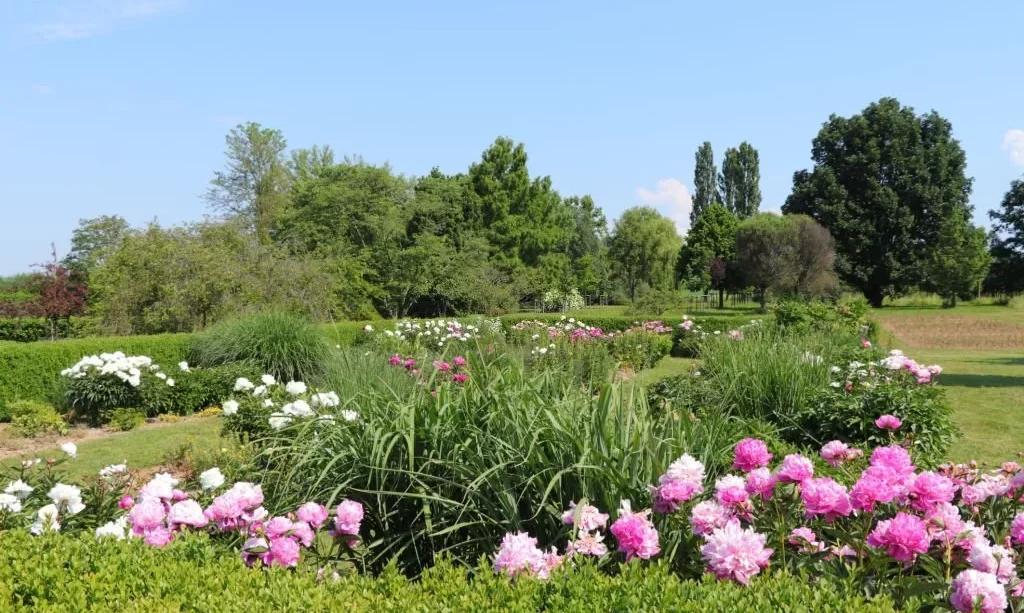The allure of peonies in the garden is undeniable. Their sumptuous, lush blooms and vibrant colors have made them a beloved perennial among garden enthusiasts. However, creating a truly captivating garden involves more than just planting peonies; it’s about crafting harmonious compositions that enhance the beauty of these exquisite flowers. In this article, we’ll explore the art of choosing companion plants for peonies. Whether you’re a seasoned gardener or just starting, learning what to plant with peonies will elevate your garden design and make your peony blooms truly shine. So, let’s embark on a journey to discover the perfect plant partners for your peonies.
- Easy to Divide: Daylilies are very easy to divide and transplant to other areas of your garden. This is a great way to propagate your plants and create a more abundant garden without new plants.
- Hardy Perennial: Daylilies are a hardy perennial that can survive in a variety of conditions. They can tolerate a wide range of soil types and can thrive in both wet and dry conditions. Once established, they require very little maintenance.
- Low Maintenance: Daylilies are relatively low maintenance plants, which means that you can spend less time worrying about them and more time enjoying your garden. They do not require regular fertilization, and only need occasional watering during dry periods.
- Long Blooming Period: Daylilies are known for their long blooming period, which can last for several weeks or even months. This means that you can enjoy their beautiful blooms for an extended period of time, adding color and interest to your garden throughout the growing season.
- Versatile: Daylily is a versatile plant that can be used in a variety of garden designs. They can be planted in mass to create a stunning display of color, used as border plants, or even as ground covers. They are also great for container gardening, so you can enjoy their beauty on your patio or balcony.
Peony Basics
Before we dive into the world of companion planting, it’s essential to understand the fundamentals of peonies themselves. Peonies come in various types, including herbaceous, tree, and intersectional hybrids. Each type has its unique growth habits, care requirements, and bloom times. Furthermore, peonies thrive in specific conditions, such as well-drained soil and ample sunlight. This knowledge will serve as the foundation for selecting suitable companion plants that will coexist harmoniously with your peonies, enriching your garden with color, texture, and fragrance.
Consider the Season
To create a garden that continually delights the eye, it’s crucial to consider the seasonality of both your peonies and their companions:
- Spring Blooms: If your peonies bloom in spring, consider planting early spring bulbs like tulips and daffodils. Their vibrant flowers will provide a burst of color just as your peonies begin to emerge.
- Summer Companions: For summer-blooming peonies, think about plants that thrive in the warmer months. Consider adding daylilies, coreopsis, or coneflowers to the mix for a dynamic mid-to-late summer display.
- Fall Accents: To extend the beauty of your garden into fall, pair fall-blooming peonies with late-season perennials like asters and sedums. These plants will pick up the floral baton as summer fades.
- PERFECT GIFT: Don’t miss the opportunity to give the gift of natural beauty to your loved one. This beautiful 4 pack of asters is the perfect present for the plant lover in your life.
- PLANT SIZE: 12” – 15″ tall from bottom of the pot to top of the plant. Your asters will continue to grow, sometimes reaching heights of 2 feet tall when cared for properly.
- SHIP STAGE: In order for you to have the maximum experience with your fresh product, all asters will be shipped with the color just starting to show on these healthy plants. They will arrive with lots of healthy buds ready to give more color throughout the entire season.
- DIRECT FROM FARM: Delivered direct from a state-of-the-art greenhouse, where our plants are grown year round under ideal conditions for maximum quality.
- PRODUCT GUARANTEE: We are confident that you will love your plants, Contact us if you have any questions about your order or have any issues with your plants.
Color Harmony
The color palette of your garden is like an artist’s canvas, and achieving harmony among the colors is key to creating a visually pleasing landscape:
- Complementary Colors: Choose companion plants that either complement or contrast with the hues of your peonies. For example, pair pink peonies with blue delphiniums for a harmonious blend, or juxtapose red peonies with yellow coreopsis for a striking contrast.
- Monochromatic Schemes: Alternatively, create a serene monochromatic scheme by selecting companion plants within the same color family as your peonies. This can result in a garden with a calming and unified color scheme.
- Foliage Considerations: Don’t forget to factor in foliage colors. Plants with interesting leaf hues, such as silver artemisia or burgundy Heuchera, can complement or contrast with peony blooms.
By carefully considering the season of bloom and the color harmony in your garden, you can orchestrate a symphony of colors that celebrates your peonies and their companions in every season.
Height and Structure
Creating a visually dynamic garden often involves varying the heights and structures of the plants you choose to accompany your peonies:
- Tall Companions: Consider tall, stately plants like delphiniums or foxgloves to provide vertical interest and a backdrop for your peonies.
- Medium Stature: Mid-sized perennials like irises or salvia can fill the middle layer of your garden, creating a sense of depth.
- Low-Growing Gems: Plant low-growing companions, such as creeping phlox or sedum, at the front of your peony bed to border and frame the taller peonies.
Balancing the heights and structures of your garden plants ensures that the eye flows effortlessly through the landscape, enhancing the overall aesthetics.
- LIVE SEDUM TILE: Charming plant mat featuring a combination of pre-planted sedum succulent plants with earthy colors and contrasting shapes. These low-growing perennial plants are easy to care for and offer endless possibilities for display.
- DIY VERTICAL GARDEN: Place this enchanting living wall planter sedum mix in a plant hanger or vertical planter alongside wall hanging plants, garden plants in a horizontal planter, flowers in a plant holder, and other garden wall decor plants.
- LOW MAINTENANCE BEAUTY: Sedum plants live happily in poor conditions and even thrive when neglected. The groundcover plants in this tile wall provide remarkable beauty with minimal effort required.
- EASY TO GROW AND PROPAGATE: Customize a tile planter with sedum seeds of your choice with hundreds of varieties of plants to choose from (e.g. creeping sedum, carpet sedum, Sedum morganianum aka sedum burrito, Sedum makinoi).
- REAL PLANTS AT YOUR DOOR: Your live plants will arrive in prime condition.
Texture and Foliage
Texture and foliage play a pivotal role in garden design, contributing depth and interest to your planting schemes:
- Leaf Textures: Mix plants with varying leaf textures, such as the fine, feathery leaves of yarrow paired with the bold, broad foliage of hostas.
- Foliage Color: Explore companion plants with interesting foliage colors and patterns. Silver lamb’s ear or burgundy heuchera can create captivating contrasts.
- Evergreen Presence: Incorporate evergreen plants like boxwood or hellebores to maintain garden interest throughout the year, even when peonies are not in bloom.
By thoughtfully combining plants with different textures and foliage characteristics, you can create a garden that beckons people to touch and explore, adding layers of depth and intrigue to your peony landscape.
Fragrance and Pollinators
A multi-sensory garden experience includes not only visual but also aromatic and ecological elements:
- Fragrant Blooms: Introduce companion plants with delightful fragrances that enhance your garden’s ambiance. Consider aromatic choices like lavender, roses, or sweet alyssum to complement the subtle fragrance of your peonies.
- Attracting Pollinators: Many companion plants can attract pollinators like bees and butterflies, benefiting both your peonies and the overall ecosystem of your garden. Flowers such as coneflowers, bee balm, and salvia are excellent choices for drawing in these essential visitors.
Creating a fragrant and pollinator-friendly garden adds an extra layer of enjoyment and ecological value to your peony landscape.
- For best results, plant in USDA Zone:4-8 – Mature size: 8-12in H x 10-12in W
- Plant is delivered in a #1 Size Container. It is fully rooted in the soil and can be planted immediately upon arrival, weather permitting.
Companion Plant Ideas
Now that we’ve explored the various aspects of companion planting with peonies, let’s dive into some specific companion plant ideas:
- For Spring-Blooming Peonies: Pair them with early spring bulbs like tulips and daffodils for a vibrant start to the season.
- For Summer-Blooming Peonies: Consider coreopsis, daylilies, and coneflowers to complement their mid-summer display.
- For Fall-Blooming Peonies: Extend the season with asters, sedums, and ornamental grasses.
- For Color Harmony: Choose plants like delphiniums, irises, and phlox that harmonize with or contrast the colors of your peonies.
- For Fragrance: Incorporate aromatic plants such as lavender, roses, and sweet alyssum.
- For Pollinators: Attract bees and butterflies with bee balm, salvia, and echinacea.
These companion plant ideas, when combined thoughtfully, can help you create a stunning and harmonious garden landscape that showcases the beauty of your peonies and provides year-round interest.
Practical Tips
To successfully plant companion plants with your peonies, consider these practical tips:
- Spacing: Ensure adequate spacing between peonies and their companions to allow for proper growth and air circulation.
- Soil Preparation: Prepare the soil for both peonies and their companions by amending it with organic matter and ensuring it drains well.
- Maintenance: Regularly deadhead spent flowers and remove any diseased or damaged foliage from both peonies and companion plants.
- Watering: Water consistently and avoid overhead watering, which can lead to disease issues.
- Mulching: Apply mulch around your plants to help retain soil moisture and prevent weeds.
- Winter Care: Consider the winter hardiness of your companion plants if you live in a region with cold winters.
- Derived from the shell of the cocoa bean, natural dark, fade resistant color and pleasing cocoa aroma
- Very lightweight and easy to spread
- Helps to smother weeds and retain moisture in your light soils
- Will not burn vegetation
- Speeds soil warm-up in the spring and protects perennial root structures
Conclusion
Creating a garden that showcases the timeless beauty of peonies is a rewarding endeavor. By carefully selecting companion plants that consider factors like seasonality, color harmony, height, texture, fragrance, and pollinator attraction, you can craft a garden that is not only visually stunning but also ecologically beneficial. With practical tips in mind, your peonies and their companions will flourish, creating a landscape that captivates the senses and invites you to savor the joys of gardening year after year. So, roll up your sleeves, get your hands in the soil, and let the art of companion planting elevate your peony garden to new heights of natural beauty.









